HGE401 - Analyzing Lifestyle Hotels & the Guest Experience Report
VerifiedAdded on 2023/05/29
|26
|8600
|376
Report
AI Summary
This report examines the evolution of lifestyle hotels in response to changing consumer behavior, particularly the demands of millennials and senior citizens. It analyzes how these hotels differentiate themselves from traditional hotels by focusing on personalized customer experiences, leveraging digital and mobile technologies, and offering unique services. The report discusses examples such as Accor Group's MGallery and Mama Shelter, Charlotte's Marriott M-Beta City Center, and W Singapore - Sentosa Cove & Resort, highlighting their strategies for attracting customers and enhancing guest satisfaction. The analysis includes a critical comparison with traditional hotels, focusing on customer service, technology integration, and personalized offerings. The report concludes with recommendations for hotels to further improve their customer experience and adapt to evolving traveler preferences.
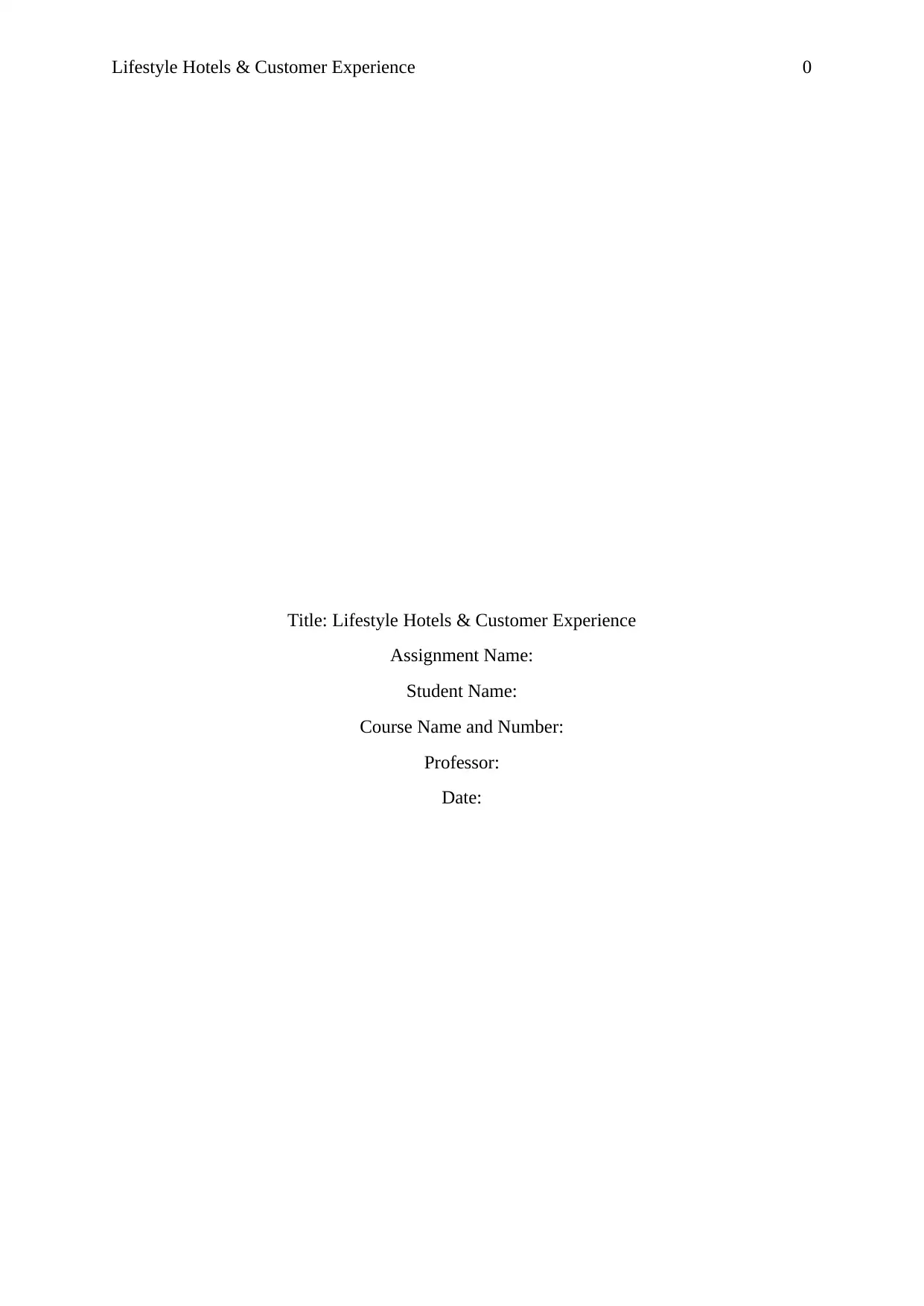
Lifestyle Hotels & Customer Experience 0
Title: Lifestyle Hotels & Customer Experience
Assignment Name:
Student Name:
Course Name and Number:
Professor:
Date:
Title: Lifestyle Hotels & Customer Experience
Assignment Name:
Student Name:
Course Name and Number:
Professor:
Date:
Paraphrase This Document
Need a fresh take? Get an instant paraphrase of this document with our AI Paraphraser
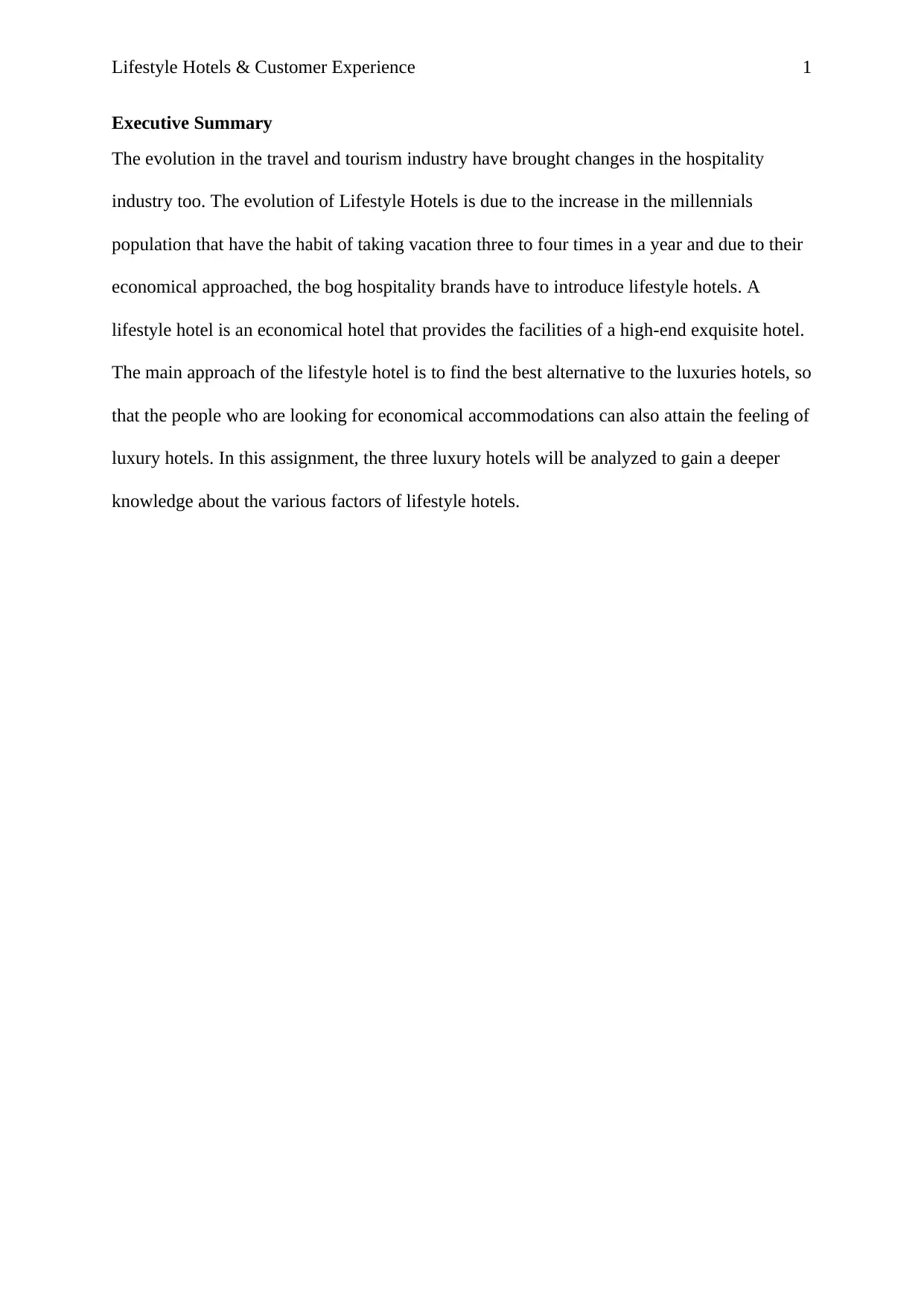
Lifestyle Hotels & Customer Experience 1
Executive Summary
The evolution in the travel and tourism industry have brought changes in the hospitality
industry too. The evolution of Lifestyle Hotels is due to the increase in the millennials
population that have the habit of taking vacation three to four times in a year and due to their
economical approached, the bog hospitality brands have to introduce lifestyle hotels. A
lifestyle hotel is an economical hotel that provides the facilities of a high-end exquisite hotel.
The main approach of the lifestyle hotel is to find the best alternative to the luxuries hotels, so
that the people who are looking for economical accommodations can also attain the feeling of
luxury hotels. In this assignment, the three luxury hotels will be analyzed to gain a deeper
knowledge about the various factors of lifestyle hotels.
Executive Summary
The evolution in the travel and tourism industry have brought changes in the hospitality
industry too. The evolution of Lifestyle Hotels is due to the increase in the millennials
population that have the habit of taking vacation three to four times in a year and due to their
economical approached, the bog hospitality brands have to introduce lifestyle hotels. A
lifestyle hotel is an economical hotel that provides the facilities of a high-end exquisite hotel.
The main approach of the lifestyle hotel is to find the best alternative to the luxuries hotels, so
that the people who are looking for economical accommodations can also attain the feeling of
luxury hotels. In this assignment, the three luxury hotels will be analyzed to gain a deeper
knowledge about the various factors of lifestyle hotels.
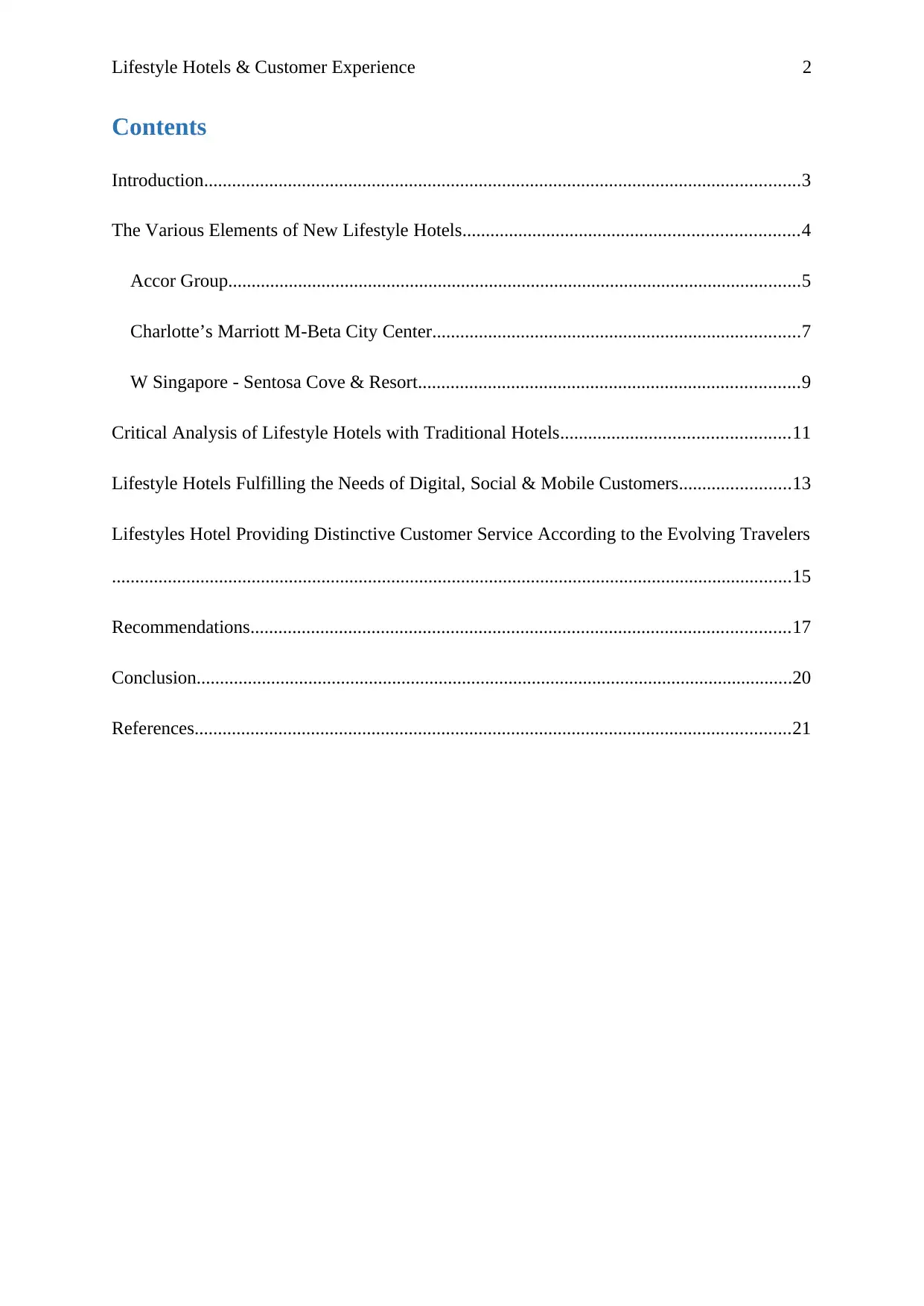
Lifestyle Hotels & Customer Experience 2
Contents
Introduction................................................................................................................................3
The Various Elements of New Lifestyle Hotels........................................................................4
Accor Group...........................................................................................................................5
Charlotte’s Marriott M-Beta City Center...............................................................................7
W Singapore - Sentosa Cove & Resort..................................................................................9
Critical Analysis of Lifestyle Hotels with Traditional Hotels.................................................11
Lifestyle Hotels Fulfilling the Needs of Digital, Social & Mobile Customers........................13
Lifestyles Hotel Providing Distinctive Customer Service According to the Evolving Travelers
..................................................................................................................................................15
Recommendations....................................................................................................................17
Conclusion................................................................................................................................20
References................................................................................................................................21
Contents
Introduction................................................................................................................................3
The Various Elements of New Lifestyle Hotels........................................................................4
Accor Group...........................................................................................................................5
Charlotte’s Marriott M-Beta City Center...............................................................................7
W Singapore - Sentosa Cove & Resort..................................................................................9
Critical Analysis of Lifestyle Hotels with Traditional Hotels.................................................11
Lifestyle Hotels Fulfilling the Needs of Digital, Social & Mobile Customers........................13
Lifestyles Hotel Providing Distinctive Customer Service According to the Evolving Travelers
..................................................................................................................................................15
Recommendations....................................................................................................................17
Conclusion................................................................................................................................20
References................................................................................................................................21
⊘ This is a preview!⊘
Do you want full access?
Subscribe today to unlock all pages.

Trusted by 1+ million students worldwide
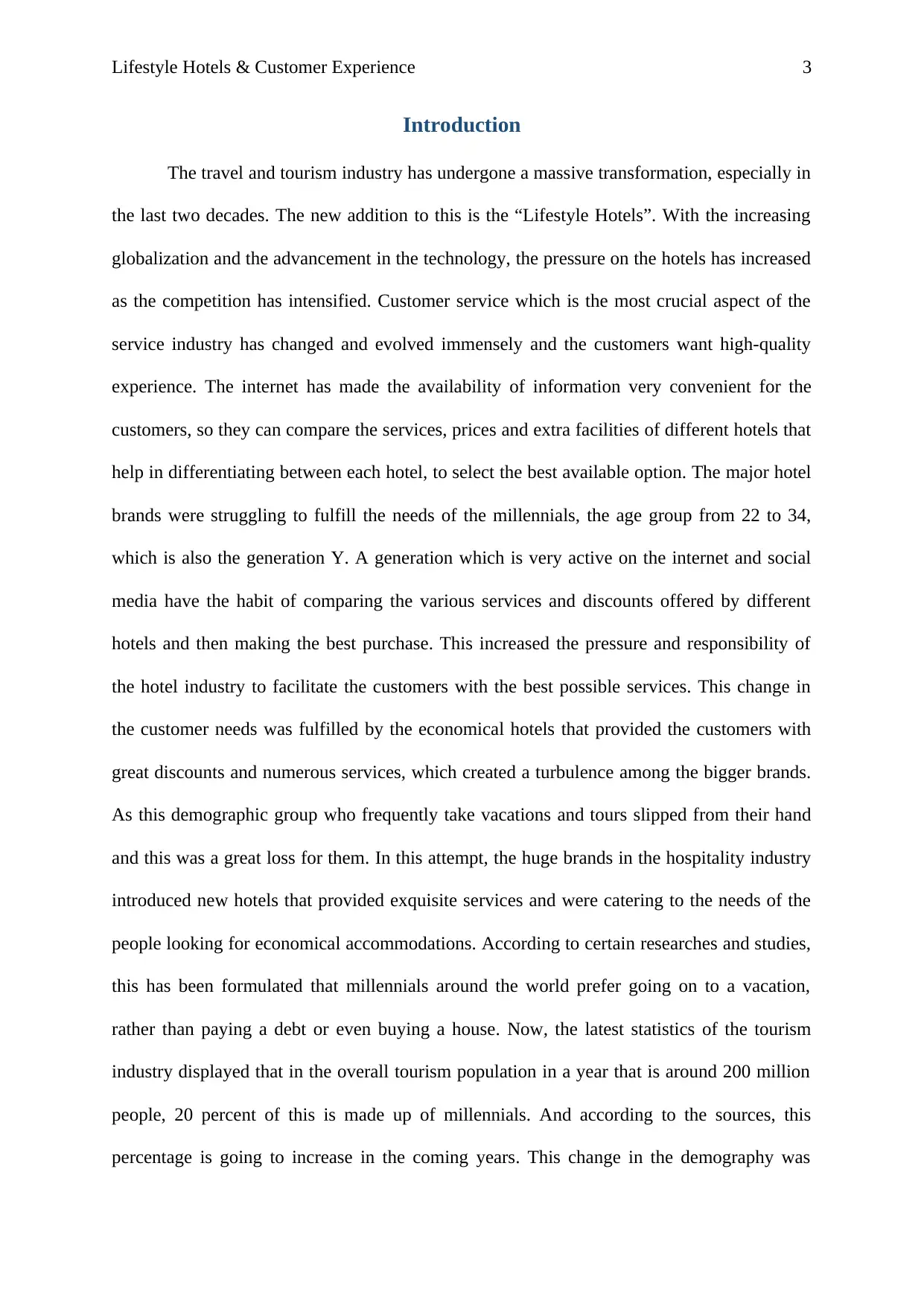
Lifestyle Hotels & Customer Experience 3
Introduction
The travel and tourism industry has undergone a massive transformation, especially in
the last two decades. The new addition to this is the “Lifestyle Hotels”. With the increasing
globalization and the advancement in the technology, the pressure on the hotels has increased
as the competition has intensified. Customer service which is the most crucial aspect of the
service industry has changed and evolved immensely and the customers want high-quality
experience. The internet has made the availability of information very convenient for the
customers, so they can compare the services, prices and extra facilities of different hotels that
help in differentiating between each hotel, to select the best available option. The major hotel
brands were struggling to fulfill the needs of the millennials, the age group from 22 to 34,
which is also the generation Y. A generation which is very active on the internet and social
media have the habit of comparing the various services and discounts offered by different
hotels and then making the best purchase. This increased the pressure and responsibility of
the hotel industry to facilitate the customers with the best possible services. This change in
the customer needs was fulfilled by the economical hotels that provided the customers with
great discounts and numerous services, which created a turbulence among the bigger brands.
As this demographic group who frequently take vacations and tours slipped from their hand
and this was a great loss for them. In this attempt, the huge brands in the hospitality industry
introduced new hotels that provided exquisite services and were catering to the needs of the
people looking for economical accommodations. According to certain researches and studies,
this has been formulated that millennials around the world prefer going on to a vacation,
rather than paying a debt or even buying a house. Now, the latest statistics of the tourism
industry displayed that in the overall tourism population in a year that is around 200 million
people, 20 percent of this is made up of millennials. And according to the sources, this
percentage is going to increase in the coming years. This change in the demography was
Introduction
The travel and tourism industry has undergone a massive transformation, especially in
the last two decades. The new addition to this is the “Lifestyle Hotels”. With the increasing
globalization and the advancement in the technology, the pressure on the hotels has increased
as the competition has intensified. Customer service which is the most crucial aspect of the
service industry has changed and evolved immensely and the customers want high-quality
experience. The internet has made the availability of information very convenient for the
customers, so they can compare the services, prices and extra facilities of different hotels that
help in differentiating between each hotel, to select the best available option. The major hotel
brands were struggling to fulfill the needs of the millennials, the age group from 22 to 34,
which is also the generation Y. A generation which is very active on the internet and social
media have the habit of comparing the various services and discounts offered by different
hotels and then making the best purchase. This increased the pressure and responsibility of
the hotel industry to facilitate the customers with the best possible services. This change in
the customer needs was fulfilled by the economical hotels that provided the customers with
great discounts and numerous services, which created a turbulence among the bigger brands.
As this demographic group who frequently take vacations and tours slipped from their hand
and this was a great loss for them. In this attempt, the huge brands in the hospitality industry
introduced new hotels that provided exquisite services and were catering to the needs of the
people looking for economical accommodations. According to certain researches and studies,
this has been formulated that millennials around the world prefer going on to a vacation,
rather than paying a debt or even buying a house. Now, the latest statistics of the tourism
industry displayed that in the overall tourism population in a year that is around 200 million
people, 20 percent of this is made up of millennials. And according to the sources, this
percentage is going to increase in the coming years. This change in the demography was
Paraphrase This Document
Need a fresh take? Get an instant paraphrase of this document with our AI Paraphraser
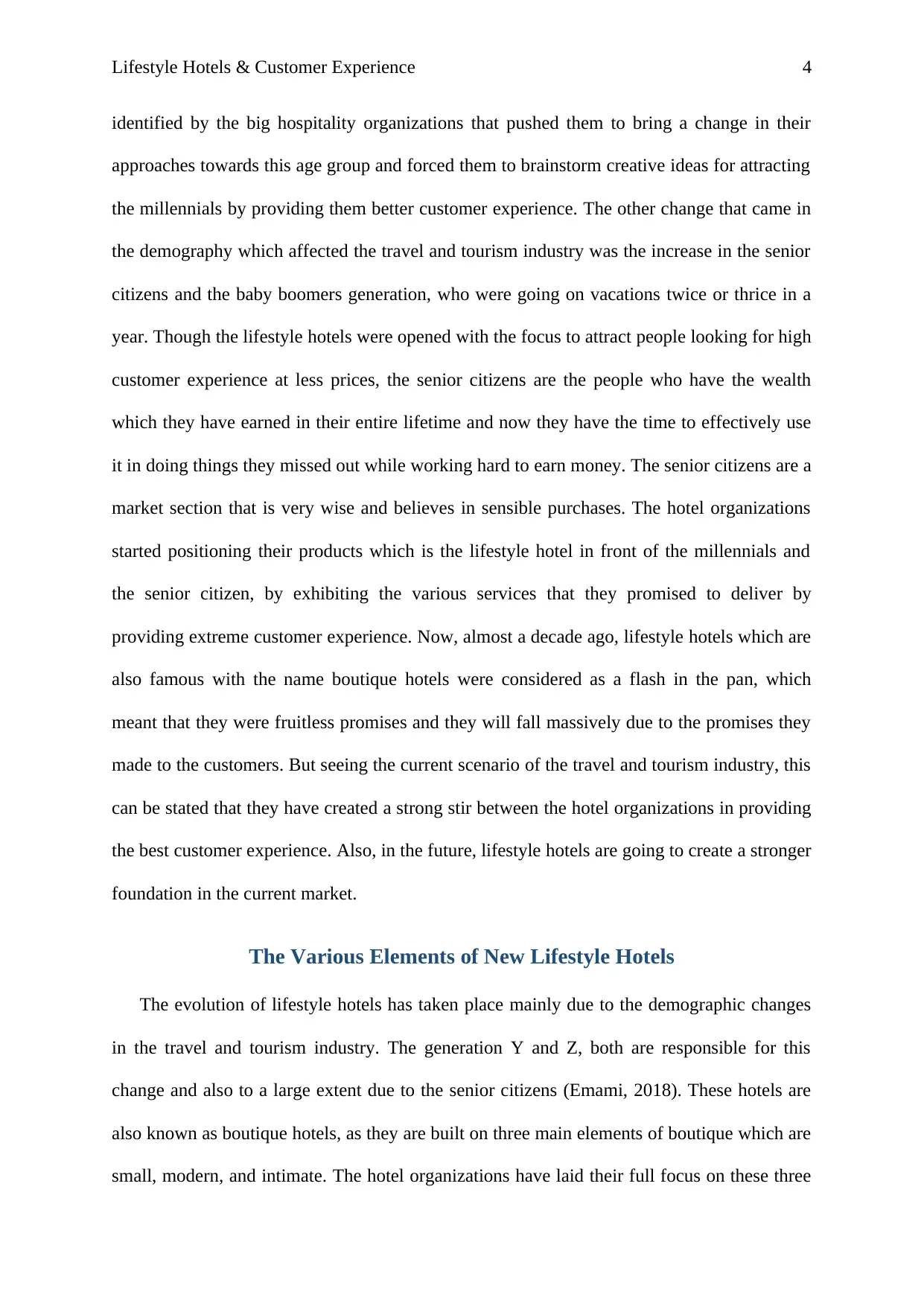
Lifestyle Hotels & Customer Experience 4
identified by the big hospitality organizations that pushed them to bring a change in their
approaches towards this age group and forced them to brainstorm creative ideas for attracting
the millennials by providing them better customer experience. The other change that came in
the demography which affected the travel and tourism industry was the increase in the senior
citizens and the baby boomers generation, who were going on vacations twice or thrice in a
year. Though the lifestyle hotels were opened with the focus to attract people looking for high
customer experience at less prices, the senior citizens are the people who have the wealth
which they have earned in their entire lifetime and now they have the time to effectively use
it in doing things they missed out while working hard to earn money. The senior citizens are a
market section that is very wise and believes in sensible purchases. The hotel organizations
started positioning their products which is the lifestyle hotel in front of the millennials and
the senior citizen, by exhibiting the various services that they promised to deliver by
providing extreme customer experience. Now, almost a decade ago, lifestyle hotels which are
also famous with the name boutique hotels were considered as a flash in the pan, which
meant that they were fruitless promises and they will fall massively due to the promises they
made to the customers. But seeing the current scenario of the travel and tourism industry, this
can be stated that they have created a strong stir between the hotel organizations in providing
the best customer experience. Also, in the future, lifestyle hotels are going to create a stronger
foundation in the current market.
The Various Elements of New Lifestyle Hotels
The evolution of lifestyle hotels has taken place mainly due to the demographic changes
in the travel and tourism industry. The generation Y and Z, both are responsible for this
change and also to a large extent due to the senior citizens (Emami, 2018). These hotels are
also known as boutique hotels, as they are built on three main elements of boutique which are
small, modern, and intimate. The hotel organizations have laid their full focus on these three
identified by the big hospitality organizations that pushed them to bring a change in their
approaches towards this age group and forced them to brainstorm creative ideas for attracting
the millennials by providing them better customer experience. The other change that came in
the demography which affected the travel and tourism industry was the increase in the senior
citizens and the baby boomers generation, who were going on vacations twice or thrice in a
year. Though the lifestyle hotels were opened with the focus to attract people looking for high
customer experience at less prices, the senior citizens are the people who have the wealth
which they have earned in their entire lifetime and now they have the time to effectively use
it in doing things they missed out while working hard to earn money. The senior citizens are a
market section that is very wise and believes in sensible purchases. The hotel organizations
started positioning their products which is the lifestyle hotel in front of the millennials and
the senior citizen, by exhibiting the various services that they promised to deliver by
providing extreme customer experience. Now, almost a decade ago, lifestyle hotels which are
also famous with the name boutique hotels were considered as a flash in the pan, which
meant that they were fruitless promises and they will fall massively due to the promises they
made to the customers. But seeing the current scenario of the travel and tourism industry, this
can be stated that they have created a strong stir between the hotel organizations in providing
the best customer experience. Also, in the future, lifestyle hotels are going to create a stronger
foundation in the current market.
The Various Elements of New Lifestyle Hotels
The evolution of lifestyle hotels has taken place mainly due to the demographic changes
in the travel and tourism industry. The generation Y and Z, both are responsible for this
change and also to a large extent due to the senior citizens (Emami, 2018). These hotels are
also known as boutique hotels, as they are built on three main elements of boutique which are
small, modern, and intimate. The hotel organizations have laid their full focus on these three
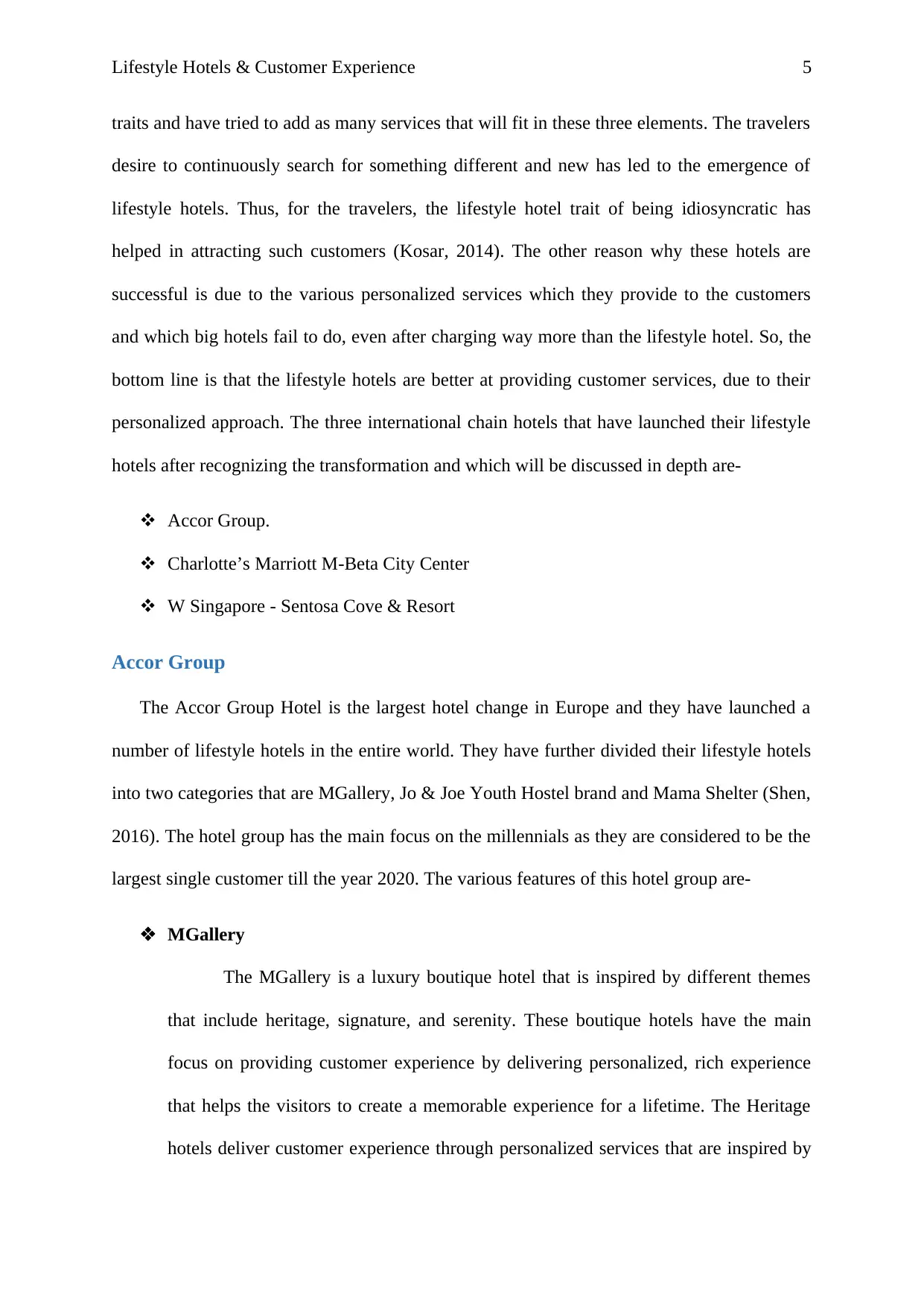
Lifestyle Hotels & Customer Experience 5
traits and have tried to add as many services that will fit in these three elements. The travelers
desire to continuously search for something different and new has led to the emergence of
lifestyle hotels. Thus, for the travelers, the lifestyle hotel trait of being idiosyncratic has
helped in attracting such customers (Kosar, 2014). The other reason why these hotels are
successful is due to the various personalized services which they provide to the customers
and which big hotels fail to do, even after charging way more than the lifestyle hotel. So, the
bottom line is that the lifestyle hotels are better at providing customer services, due to their
personalized approach. The three international chain hotels that have launched their lifestyle
hotels after recognizing the transformation and which will be discussed in depth are-
Accor Group.
Charlotte’s Marriott M-Beta City Center
W Singapore - Sentosa Cove & Resort
Accor Group
The Accor Group Hotel is the largest hotel change in Europe and they have launched a
number of lifestyle hotels in the entire world. They have further divided their lifestyle hotels
into two categories that are MGallery, Jo & Joe Youth Hostel brand and Mama Shelter (Shen,
2016). The hotel group has the main focus on the millennials as they are considered to be the
largest single customer till the year 2020. The various features of this hotel group are-
MGallery
The MGallery is a luxury boutique hotel that is inspired by different themes
that include heritage, signature, and serenity. These boutique hotels have the main
focus on providing customer experience by delivering personalized, rich experience
that helps the visitors to create a memorable experience for a lifetime. The Heritage
hotels deliver customer experience through personalized services that are inspired by
traits and have tried to add as many services that will fit in these three elements. The travelers
desire to continuously search for something different and new has led to the emergence of
lifestyle hotels. Thus, for the travelers, the lifestyle hotel trait of being idiosyncratic has
helped in attracting such customers (Kosar, 2014). The other reason why these hotels are
successful is due to the various personalized services which they provide to the customers
and which big hotels fail to do, even after charging way more than the lifestyle hotel. So, the
bottom line is that the lifestyle hotels are better at providing customer services, due to their
personalized approach. The three international chain hotels that have launched their lifestyle
hotels after recognizing the transformation and which will be discussed in depth are-
Accor Group.
Charlotte’s Marriott M-Beta City Center
W Singapore - Sentosa Cove & Resort
Accor Group
The Accor Group Hotel is the largest hotel change in Europe and they have launched a
number of lifestyle hotels in the entire world. They have further divided their lifestyle hotels
into two categories that are MGallery, Jo & Joe Youth Hostel brand and Mama Shelter (Shen,
2016). The hotel group has the main focus on the millennials as they are considered to be the
largest single customer till the year 2020. The various features of this hotel group are-
MGallery
The MGallery is a luxury boutique hotel that is inspired by different themes
that include heritage, signature, and serenity. These boutique hotels have the main
focus on providing customer experience by delivering personalized, rich experience
that helps the visitors to create a memorable experience for a lifetime. The Heritage
hotels deliver customer experience through personalized services that are inspired by
⊘ This is a preview!⊘
Do you want full access?
Subscribe today to unlock all pages.

Trusted by 1+ million students worldwide
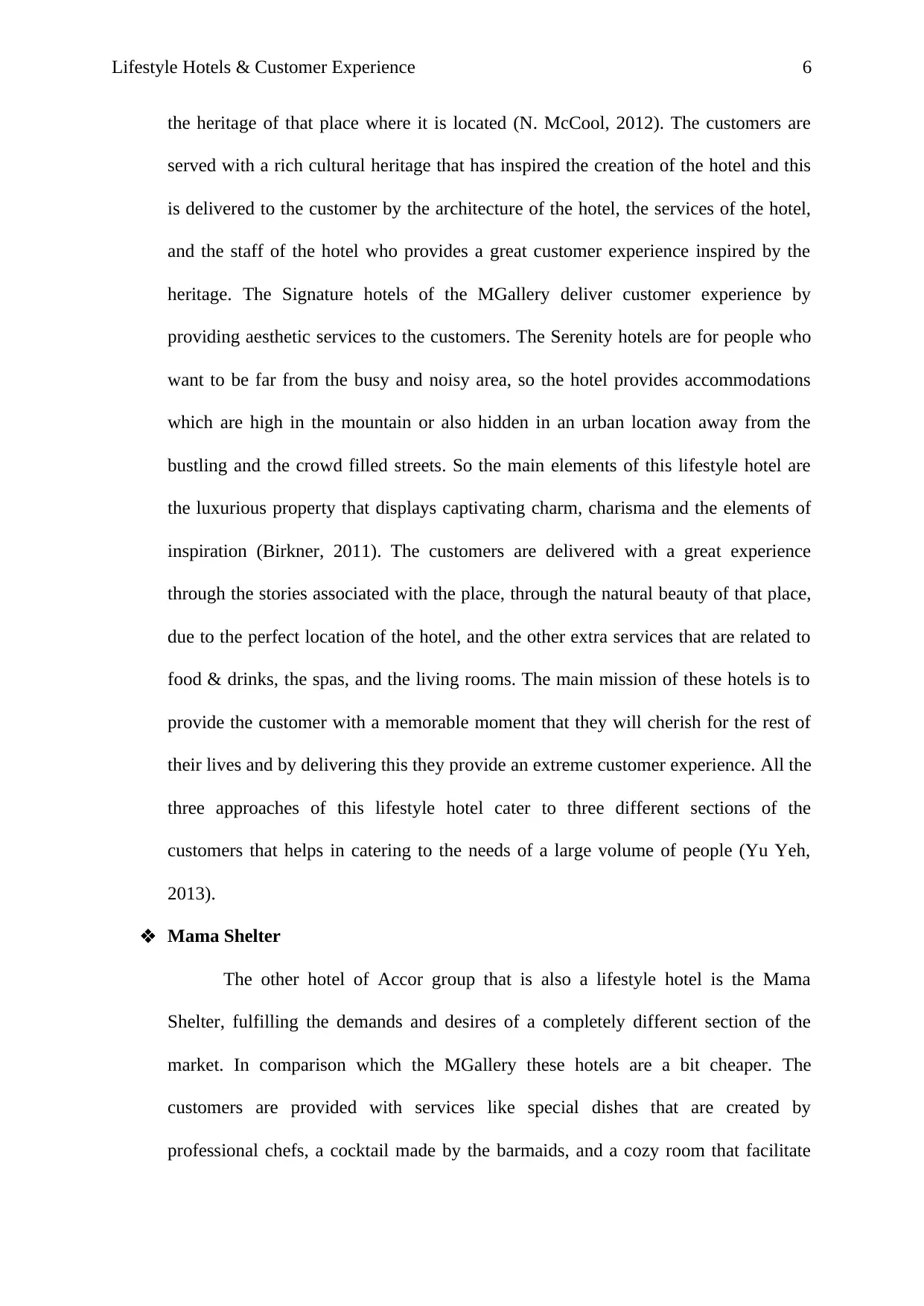
Lifestyle Hotels & Customer Experience 6
the heritage of that place where it is located (N. McCool, 2012). The customers are
served with a rich cultural heritage that has inspired the creation of the hotel and this
is delivered to the customer by the architecture of the hotel, the services of the hotel,
and the staff of the hotel who provides a great customer experience inspired by the
heritage. The Signature hotels of the MGallery deliver customer experience by
providing aesthetic services to the customers. The Serenity hotels are for people who
want to be far from the busy and noisy area, so the hotel provides accommodations
which are high in the mountain or also hidden in an urban location away from the
bustling and the crowd filled streets. So the main elements of this lifestyle hotel are
the luxurious property that displays captivating charm, charisma and the elements of
inspiration (Birkner, 2011). The customers are delivered with a great experience
through the stories associated with the place, through the natural beauty of that place,
due to the perfect location of the hotel, and the other extra services that are related to
food & drinks, the spas, and the living rooms. The main mission of these hotels is to
provide the customer with a memorable moment that they will cherish for the rest of
their lives and by delivering this they provide an extreme customer experience. All the
three approaches of this lifestyle hotel cater to three different sections of the
customers that helps in catering to the needs of a large volume of people (Yu Yeh,
2013).
Mama Shelter
The other hotel of Accor group that is also a lifestyle hotel is the Mama
Shelter, fulfilling the demands and desires of a completely different section of the
market. In comparison which the MGallery these hotels are a bit cheaper. The
customers are provided with services like special dishes that are created by
professional chefs, a cocktail made by the barmaids, and a cozy room that facilitate
the heritage of that place where it is located (N. McCool, 2012). The customers are
served with a rich cultural heritage that has inspired the creation of the hotel and this
is delivered to the customer by the architecture of the hotel, the services of the hotel,
and the staff of the hotel who provides a great customer experience inspired by the
heritage. The Signature hotels of the MGallery deliver customer experience by
providing aesthetic services to the customers. The Serenity hotels are for people who
want to be far from the busy and noisy area, so the hotel provides accommodations
which are high in the mountain or also hidden in an urban location away from the
bustling and the crowd filled streets. So the main elements of this lifestyle hotel are
the luxurious property that displays captivating charm, charisma and the elements of
inspiration (Birkner, 2011). The customers are delivered with a great experience
through the stories associated with the place, through the natural beauty of that place,
due to the perfect location of the hotel, and the other extra services that are related to
food & drinks, the spas, and the living rooms. The main mission of these hotels is to
provide the customer with a memorable moment that they will cherish for the rest of
their lives and by delivering this they provide an extreme customer experience. All the
three approaches of this lifestyle hotel cater to three different sections of the
customers that helps in catering to the needs of a large volume of people (Yu Yeh,
2013).
Mama Shelter
The other hotel of Accor group that is also a lifestyle hotel is the Mama
Shelter, fulfilling the demands and desires of a completely different section of the
market. In comparison which the MGallery these hotels are a bit cheaper. The
customers are provided with services like special dishes that are created by
professional chefs, a cocktail made by the barmaids, and a cozy room that facilitate
Paraphrase This Document
Need a fresh take? Get an instant paraphrase of this document with our AI Paraphraser
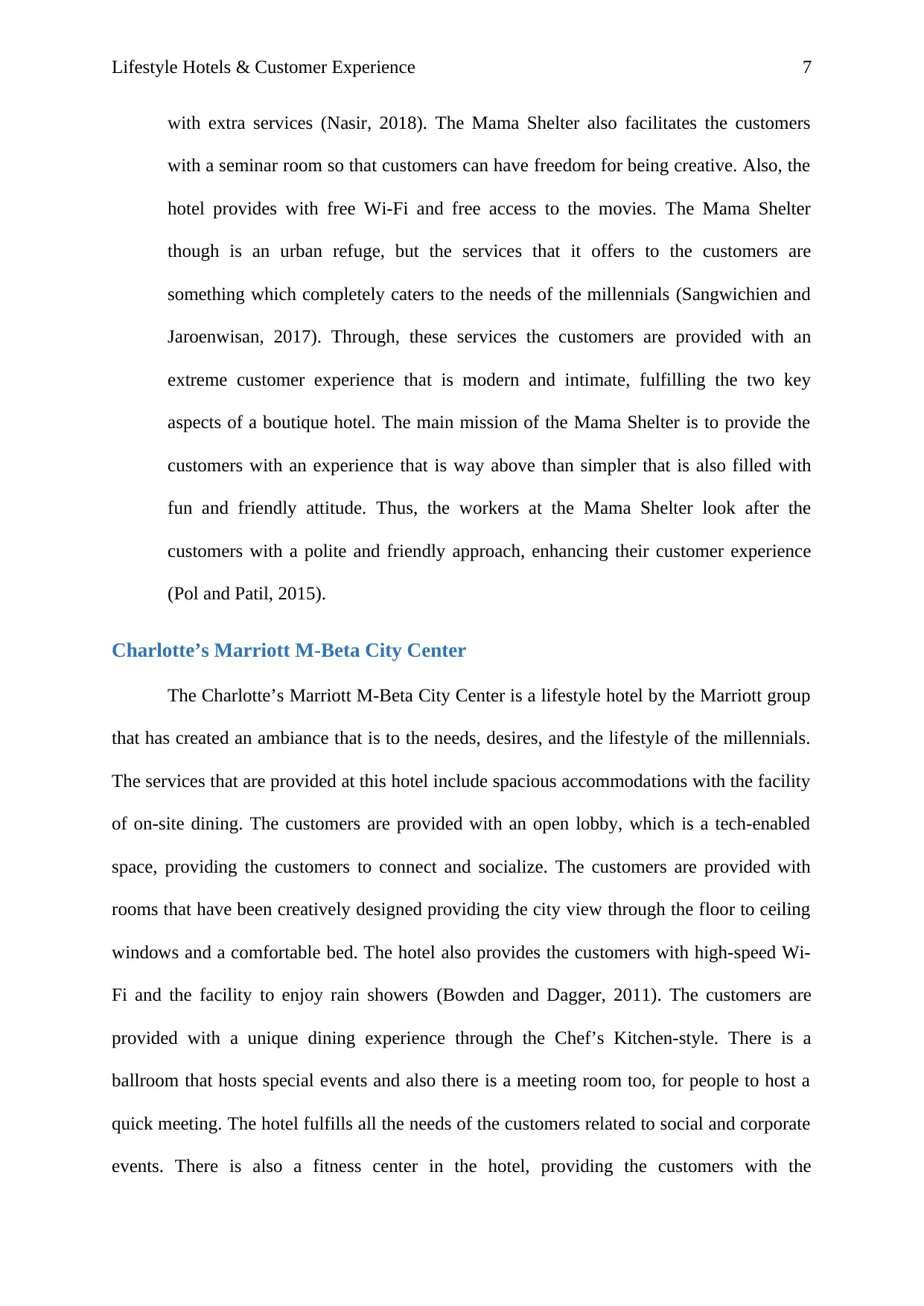
Lifestyle Hotels & Customer Experience 7
with extra services (Nasir, 2018). The Mama Shelter also facilitates the customers
with a seminar room so that customers can have freedom for being creative. Also, the
hotel provides with free Wi-Fi and free access to the movies. The Mama Shelter
though is an urban refuge, but the services that it offers to the customers are
something which completely caters to the needs of the millennials (Sangwichien and
Jaroenwisan, 2017). Through, these services the customers are provided with an
extreme customer experience that is modern and intimate, fulfilling the two key
aspects of a boutique hotel. The main mission of the Mama Shelter is to provide the
customers with an experience that is way above than simpler that is also filled with
fun and friendly attitude. Thus, the workers at the Mama Shelter look after the
customers with a polite and friendly approach, enhancing their customer experience
(Pol and Patil, 2015).
Charlotte’s Marriott M-Beta City Center
The Charlotte’s Marriott M-Beta City Center is a lifestyle hotel by the Marriott group
that has created an ambiance that is to the needs, desires, and the lifestyle of the millennials.
The services that are provided at this hotel include spacious accommodations with the facility
of on-site dining. The customers are provided with an open lobby, which is a tech-enabled
space, providing the customers to connect and socialize. The customers are provided with
rooms that have been creatively designed providing the city view through the floor to ceiling
windows and a comfortable bed. The hotel also provides the customers with high-speed Wi-
Fi and the facility to enjoy rain showers (Bowden and Dagger, 2011). The customers are
provided with a unique dining experience through the Chef’s Kitchen-style. There is a
ballroom that hosts special events and also there is a meeting room too, for people to host a
quick meeting. The hotel fulfills all the needs of the customers related to social and corporate
events. There is also a fitness center in the hotel, providing the customers with the
with extra services (Nasir, 2018). The Mama Shelter also facilitates the customers
with a seminar room so that customers can have freedom for being creative. Also, the
hotel provides with free Wi-Fi and free access to the movies. The Mama Shelter
though is an urban refuge, but the services that it offers to the customers are
something which completely caters to the needs of the millennials (Sangwichien and
Jaroenwisan, 2017). Through, these services the customers are provided with an
extreme customer experience that is modern and intimate, fulfilling the two key
aspects of a boutique hotel. The main mission of the Mama Shelter is to provide the
customers with an experience that is way above than simpler that is also filled with
fun and friendly attitude. Thus, the workers at the Mama Shelter look after the
customers with a polite and friendly approach, enhancing their customer experience
(Pol and Patil, 2015).
Charlotte’s Marriott M-Beta City Center
The Charlotte’s Marriott M-Beta City Center is a lifestyle hotel by the Marriott group
that has created an ambiance that is to the needs, desires, and the lifestyle of the millennials.
The services that are provided at this hotel include spacious accommodations with the facility
of on-site dining. The customers are provided with an open lobby, which is a tech-enabled
space, providing the customers to connect and socialize. The customers are provided with
rooms that have been creatively designed providing the city view through the floor to ceiling
windows and a comfortable bed. The hotel also provides the customers with high-speed Wi-
Fi and the facility to enjoy rain showers (Bowden and Dagger, 2011). The customers are
provided with a unique dining experience through the Chef’s Kitchen-style. There is a
ballroom that hosts special events and also there is a meeting room too, for people to host a
quick meeting. The hotel fulfills all the needs of the customers related to social and corporate
events. There is also a fitness center in the hotel, providing the customers with the
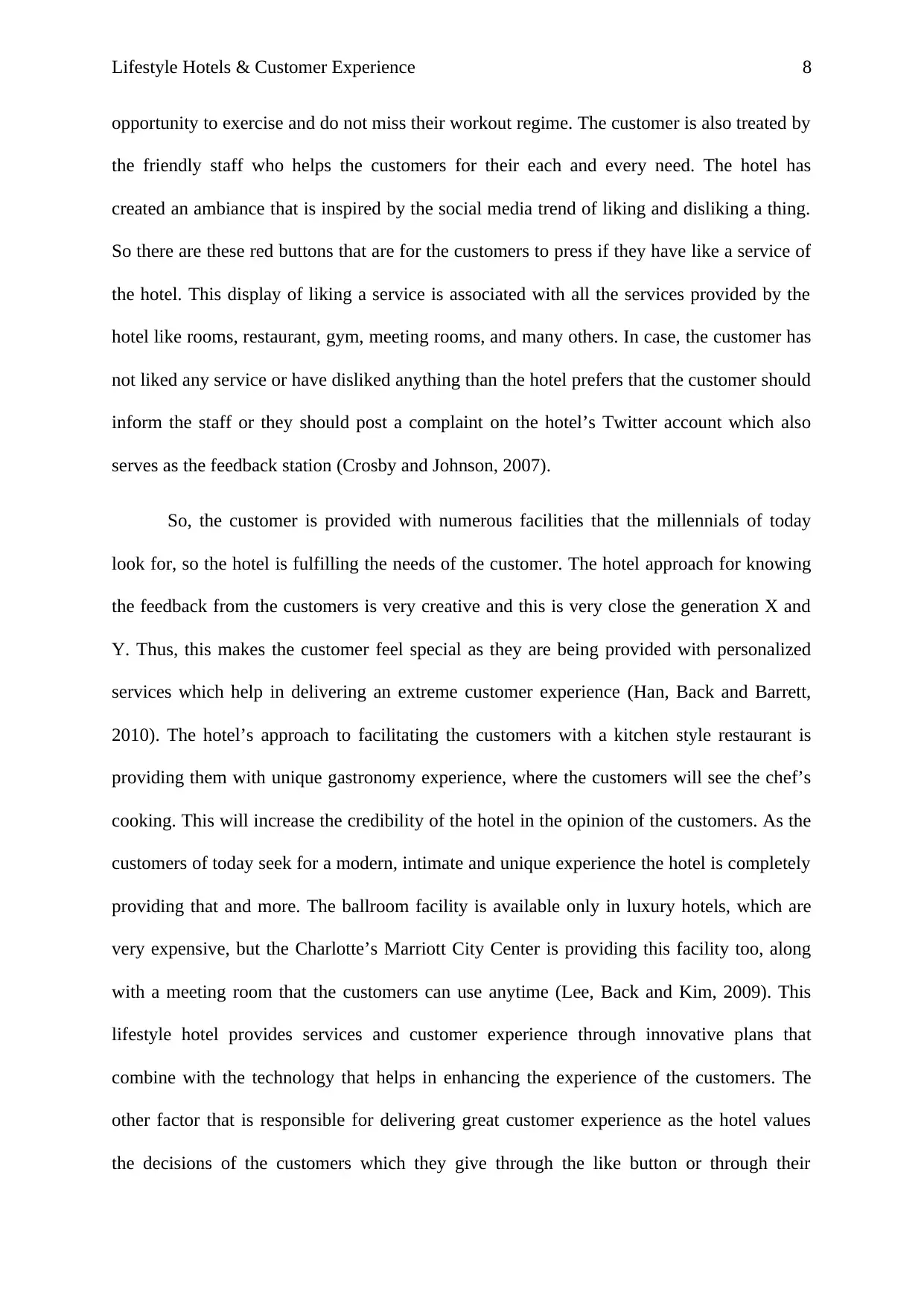
Lifestyle Hotels & Customer Experience 8
opportunity to exercise and do not miss their workout regime. The customer is also treated by
the friendly staff who helps the customers for their each and every need. The hotel has
created an ambiance that is inspired by the social media trend of liking and disliking a thing.
So there are these red buttons that are for the customers to press if they have like a service of
the hotel. This display of liking a service is associated with all the services provided by the
hotel like rooms, restaurant, gym, meeting rooms, and many others. In case, the customer has
not liked any service or have disliked anything than the hotel prefers that the customer should
inform the staff or they should post a complaint on the hotel’s Twitter account which also
serves as the feedback station (Crosby and Johnson, 2007).
So, the customer is provided with numerous facilities that the millennials of today
look for, so the hotel is fulfilling the needs of the customer. The hotel approach for knowing
the feedback from the customers is very creative and this is very close the generation X and
Y. Thus, this makes the customer feel special as they are being provided with personalized
services which help in delivering an extreme customer experience (Han, Back and Barrett,
2010). The hotel’s approach to facilitating the customers with a kitchen style restaurant is
providing them with unique gastronomy experience, where the customers will see the chef’s
cooking. This will increase the credibility of the hotel in the opinion of the customers. As the
customers of today seek for a modern, intimate and unique experience the hotel is completely
providing that and more. The ballroom facility is available only in luxury hotels, which are
very expensive, but the Charlotte’s Marriott City Center is providing this facility too, along
with a meeting room that the customers can use anytime (Lee, Back and Kim, 2009). This
lifestyle hotel provides services and customer experience through innovative plans that
combine with the technology that helps in enhancing the experience of the customers. The
other factor that is responsible for delivering great customer experience as the hotel values
the decisions of the customers which they give through the like button or through their
opportunity to exercise and do not miss their workout regime. The customer is also treated by
the friendly staff who helps the customers for their each and every need. The hotel has
created an ambiance that is inspired by the social media trend of liking and disliking a thing.
So there are these red buttons that are for the customers to press if they have like a service of
the hotel. This display of liking a service is associated with all the services provided by the
hotel like rooms, restaurant, gym, meeting rooms, and many others. In case, the customer has
not liked any service or have disliked anything than the hotel prefers that the customer should
inform the staff or they should post a complaint on the hotel’s Twitter account which also
serves as the feedback station (Crosby and Johnson, 2007).
So, the customer is provided with numerous facilities that the millennials of today
look for, so the hotel is fulfilling the needs of the customer. The hotel approach for knowing
the feedback from the customers is very creative and this is very close the generation X and
Y. Thus, this makes the customer feel special as they are being provided with personalized
services which help in delivering an extreme customer experience (Han, Back and Barrett,
2010). The hotel’s approach to facilitating the customers with a kitchen style restaurant is
providing them with unique gastronomy experience, where the customers will see the chef’s
cooking. This will increase the credibility of the hotel in the opinion of the customers. As the
customers of today seek for a modern, intimate and unique experience the hotel is completely
providing that and more. The ballroom facility is available only in luxury hotels, which are
very expensive, but the Charlotte’s Marriott City Center is providing this facility too, along
with a meeting room that the customers can use anytime (Lee, Back and Kim, 2009). This
lifestyle hotel provides services and customer experience through innovative plans that
combine with the technology that helps in enhancing the experience of the customers. The
other factor that is responsible for delivering great customer experience as the hotel values
the decisions of the customers which they give through the like button or through their
⊘ This is a preview!⊘
Do you want full access?
Subscribe today to unlock all pages.

Trusted by 1+ million students worldwide
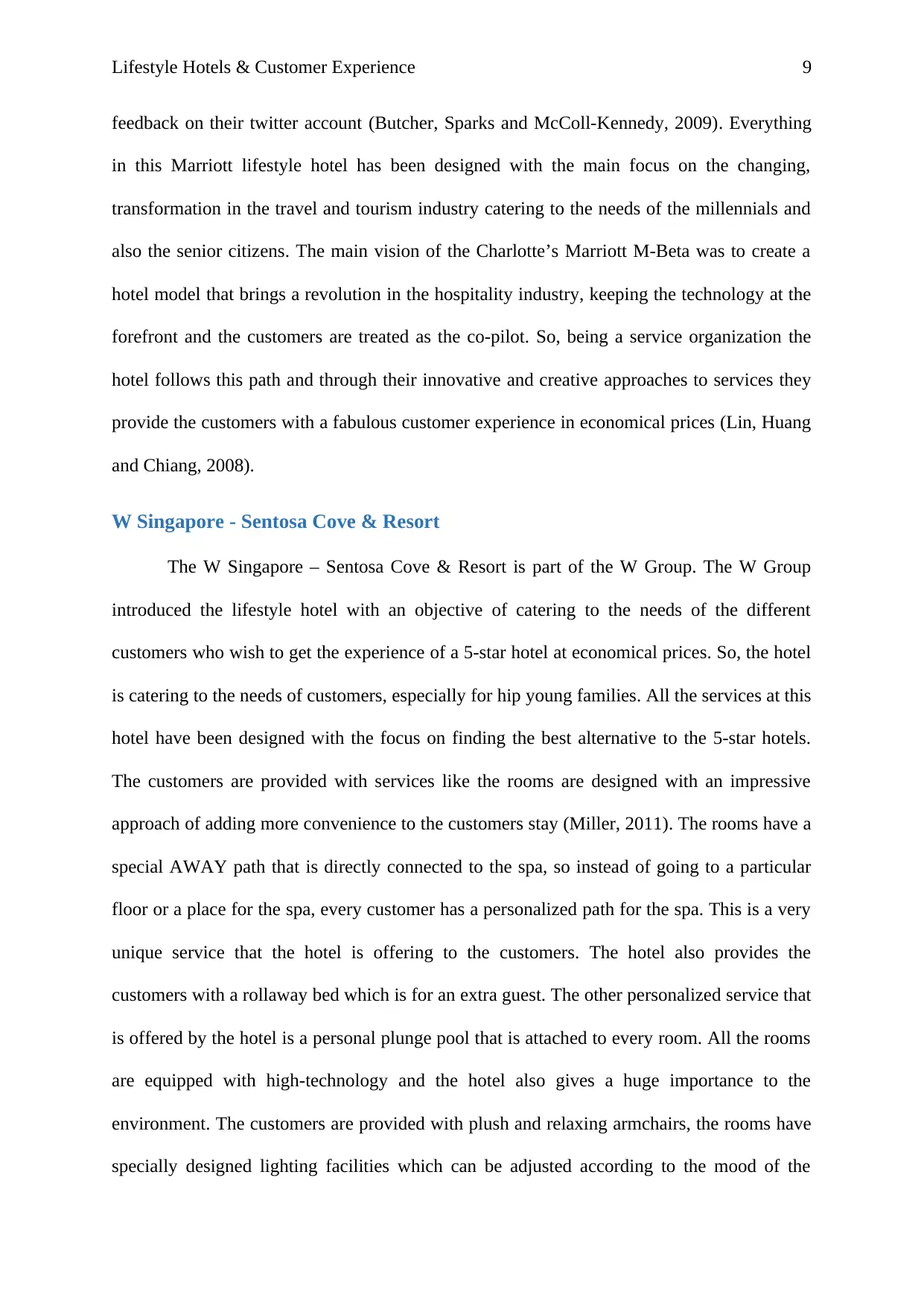
Lifestyle Hotels & Customer Experience 9
feedback on their twitter account (Butcher, Sparks and McColl-Kennedy, 2009). Everything
in this Marriott lifestyle hotel has been designed with the main focus on the changing,
transformation in the travel and tourism industry catering to the needs of the millennials and
also the senior citizens. The main vision of the Charlotte’s Marriott M-Beta was to create a
hotel model that brings a revolution in the hospitality industry, keeping the technology at the
forefront and the customers are treated as the co-pilot. So, being a service organization the
hotel follows this path and through their innovative and creative approaches to services they
provide the customers with a fabulous customer experience in economical prices (Lin, Huang
and Chiang, 2008).
W Singapore - Sentosa Cove & Resort
The W Singapore – Sentosa Cove & Resort is part of the W Group. The W Group
introduced the lifestyle hotel with an objective of catering to the needs of the different
customers who wish to get the experience of a 5-star hotel at economical prices. So, the hotel
is catering to the needs of customers, especially for hip young families. All the services at this
hotel have been designed with the focus on finding the best alternative to the 5-star hotels.
The customers are provided with services like the rooms are designed with an impressive
approach of adding more convenience to the customers stay (Miller, 2011). The rooms have a
special AWAY path that is directly connected to the spa, so instead of going to a particular
floor or a place for the spa, every customer has a personalized path for the spa. This is a very
unique service that the hotel is offering to the customers. The hotel also provides the
customers with a rollaway bed which is for an extra guest. The other personalized service that
is offered by the hotel is a personal plunge pool that is attached to every room. All the rooms
are equipped with high-technology and the hotel also gives a huge importance to the
environment. The customers are provided with plush and relaxing armchairs, the rooms have
specially designed lighting facilities which can be adjusted according to the mood of the
feedback on their twitter account (Butcher, Sparks and McColl-Kennedy, 2009). Everything
in this Marriott lifestyle hotel has been designed with the main focus on the changing,
transformation in the travel and tourism industry catering to the needs of the millennials and
also the senior citizens. The main vision of the Charlotte’s Marriott M-Beta was to create a
hotel model that brings a revolution in the hospitality industry, keeping the technology at the
forefront and the customers are treated as the co-pilot. So, being a service organization the
hotel follows this path and through their innovative and creative approaches to services they
provide the customers with a fabulous customer experience in economical prices (Lin, Huang
and Chiang, 2008).
W Singapore - Sentosa Cove & Resort
The W Singapore – Sentosa Cove & Resort is part of the W Group. The W Group
introduced the lifestyle hotel with an objective of catering to the needs of the different
customers who wish to get the experience of a 5-star hotel at economical prices. So, the hotel
is catering to the needs of customers, especially for hip young families. All the services at this
hotel have been designed with the focus on finding the best alternative to the 5-star hotels.
The customers are provided with services like the rooms are designed with an impressive
approach of adding more convenience to the customers stay (Miller, 2011). The rooms have a
special AWAY path that is directly connected to the spa, so instead of going to a particular
floor or a place for the spa, every customer has a personalized path for the spa. This is a very
unique service that the hotel is offering to the customers. The hotel also provides the
customers with a rollaway bed which is for an extra guest. The other personalized service that
is offered by the hotel is a personal plunge pool that is attached to every room. All the rooms
are equipped with high-technology and the hotel also gives a huge importance to the
environment. The customers are provided with plush and relaxing armchairs, the rooms have
specially designed lighting facilities which can be adjusted according to the mood of the
Paraphrase This Document
Need a fresh take? Get an instant paraphrase of this document with our AI Paraphraser
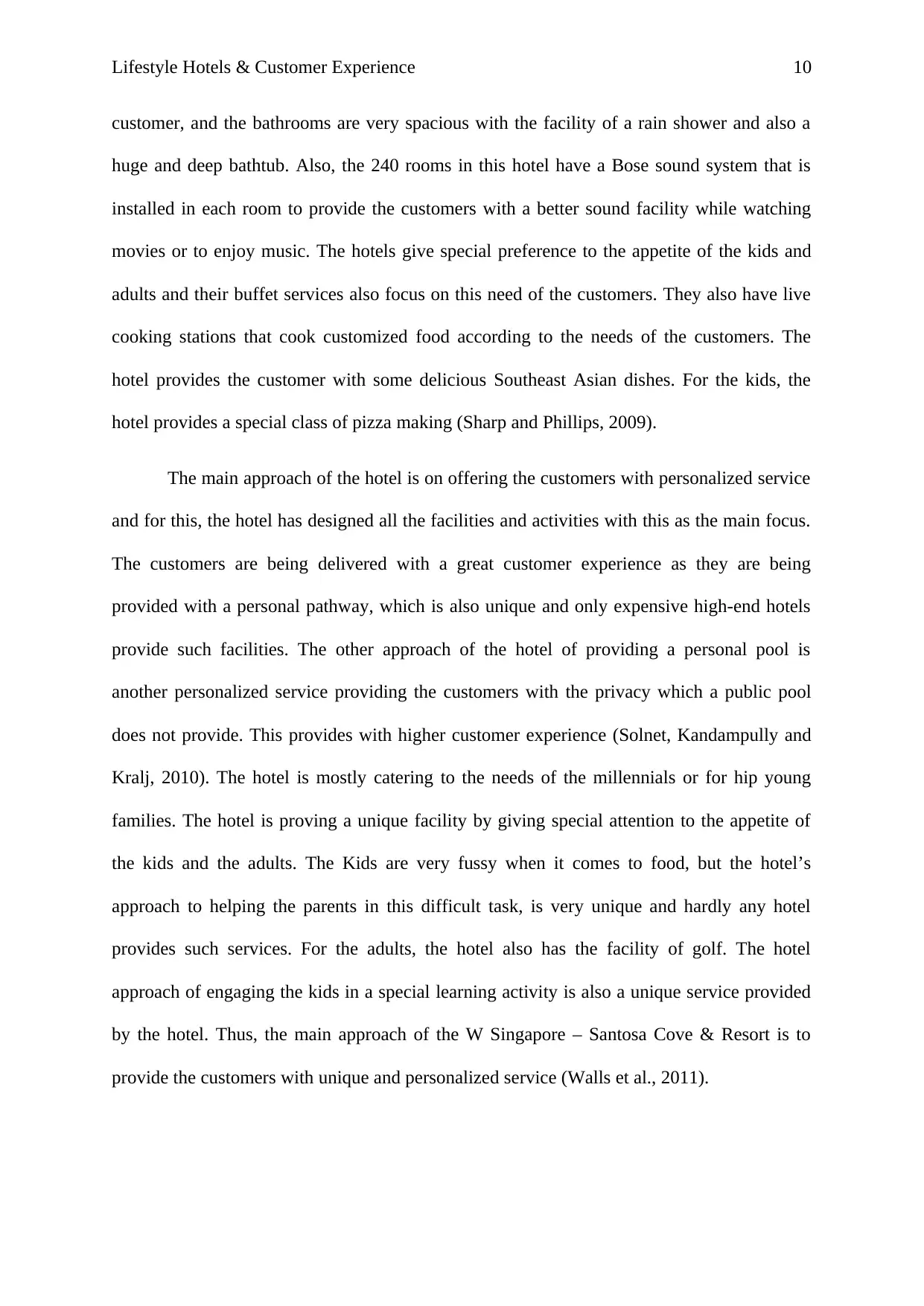
Lifestyle Hotels & Customer Experience 10
customer, and the bathrooms are very spacious with the facility of a rain shower and also a
huge and deep bathtub. Also, the 240 rooms in this hotel have a Bose sound system that is
installed in each room to provide the customers with a better sound facility while watching
movies or to enjoy music. The hotels give special preference to the appetite of the kids and
adults and their buffet services also focus on this need of the customers. They also have live
cooking stations that cook customized food according to the needs of the customers. The
hotel provides the customer with some delicious Southeast Asian dishes. For the kids, the
hotel provides a special class of pizza making (Sharp and Phillips, 2009).
The main approach of the hotel is on offering the customers with personalized service
and for this, the hotel has designed all the facilities and activities with this as the main focus.
The customers are being delivered with a great customer experience as they are being
provided with a personal pathway, which is also unique and only expensive high-end hotels
provide such facilities. The other approach of the hotel of providing a personal pool is
another personalized service providing the customers with the privacy which a public pool
does not provide. This provides with higher customer experience (Solnet, Kandampully and
Kralj, 2010). The hotel is mostly catering to the needs of the millennials or for hip young
families. The hotel is proving a unique facility by giving special attention to the appetite of
the kids and the adults. The Kids are very fussy when it comes to food, but the hotel’s
approach to helping the parents in this difficult task, is very unique and hardly any hotel
provides such services. For the adults, the hotel also has the facility of golf. The hotel
approach of engaging the kids in a special learning activity is also a unique service provided
by the hotel. Thus, the main approach of the W Singapore – Santosa Cove & Resort is to
provide the customers with unique and personalized service (Walls et al., 2011).
customer, and the bathrooms are very spacious with the facility of a rain shower and also a
huge and deep bathtub. Also, the 240 rooms in this hotel have a Bose sound system that is
installed in each room to provide the customers with a better sound facility while watching
movies or to enjoy music. The hotels give special preference to the appetite of the kids and
adults and their buffet services also focus on this need of the customers. They also have live
cooking stations that cook customized food according to the needs of the customers. The
hotel provides the customer with some delicious Southeast Asian dishes. For the kids, the
hotel provides a special class of pizza making (Sharp and Phillips, 2009).
The main approach of the hotel is on offering the customers with personalized service
and for this, the hotel has designed all the facilities and activities with this as the main focus.
The customers are being delivered with a great customer experience as they are being
provided with a personal pathway, which is also unique and only expensive high-end hotels
provide such facilities. The other approach of the hotel of providing a personal pool is
another personalized service providing the customers with the privacy which a public pool
does not provide. This provides with higher customer experience (Solnet, Kandampully and
Kralj, 2010). The hotel is mostly catering to the needs of the millennials or for hip young
families. The hotel is proving a unique facility by giving special attention to the appetite of
the kids and the adults. The Kids are very fussy when it comes to food, but the hotel’s
approach to helping the parents in this difficult task, is very unique and hardly any hotel
provides such services. For the adults, the hotel also has the facility of golf. The hotel
approach of engaging the kids in a special learning activity is also a unique service provided
by the hotel. Thus, the main approach of the W Singapore – Santosa Cove & Resort is to
provide the customers with unique and personalized service (Walls et al., 2011).
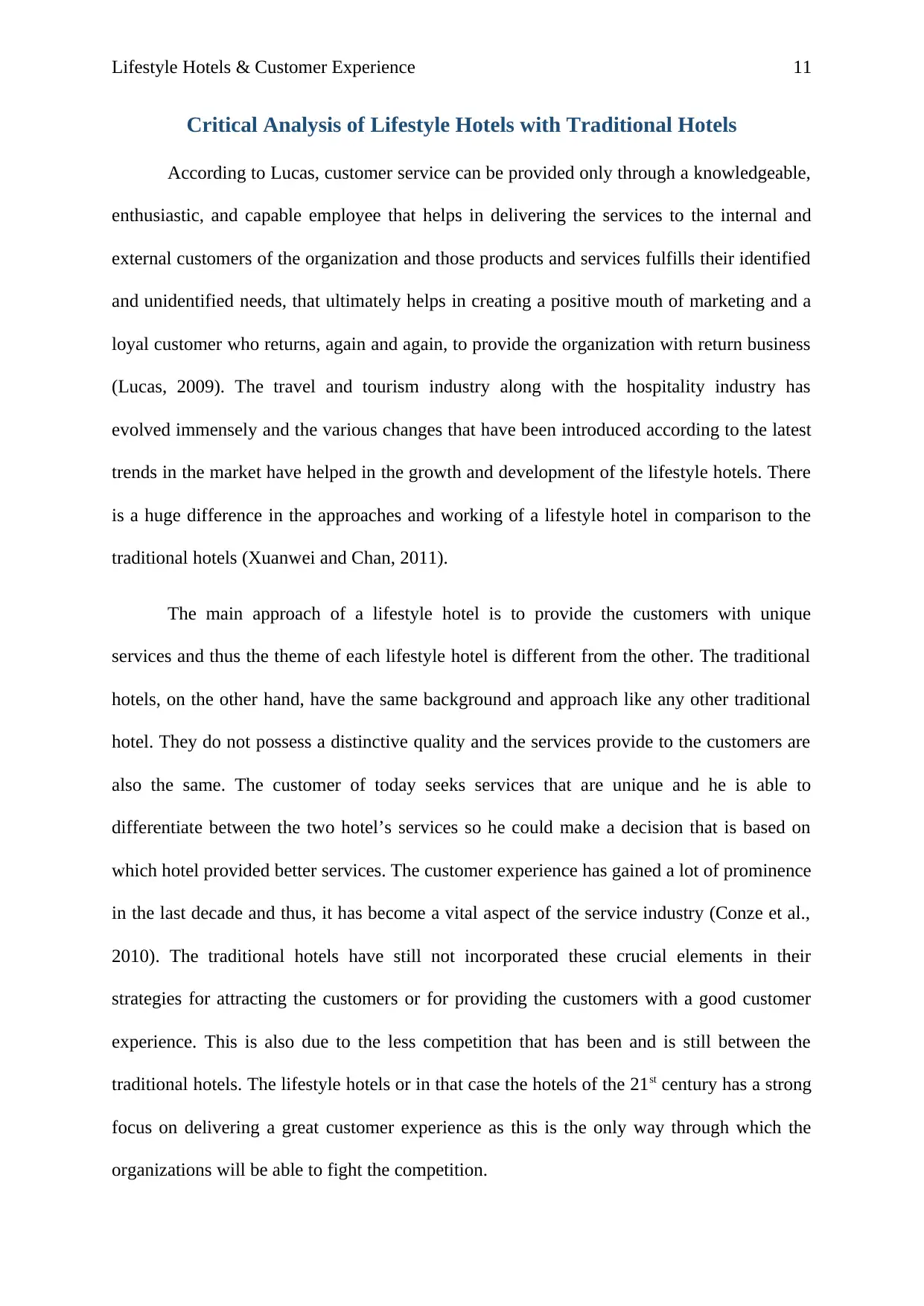
Lifestyle Hotels & Customer Experience 11
Critical Analysis of Lifestyle Hotels with Traditional Hotels
According to Lucas, customer service can be provided only through a knowledgeable,
enthusiastic, and capable employee that helps in delivering the services to the internal and
external customers of the organization and those products and services fulfills their identified
and unidentified needs, that ultimately helps in creating a positive mouth of marketing and a
loyal customer who returns, again and again, to provide the organization with return business
(Lucas, 2009). The travel and tourism industry along with the hospitality industry has
evolved immensely and the various changes that have been introduced according to the latest
trends in the market have helped in the growth and development of the lifestyle hotels. There
is a huge difference in the approaches and working of a lifestyle hotel in comparison to the
traditional hotels (Xuanwei and Chan, 2011).
The main approach of a lifestyle hotel is to provide the customers with unique
services and thus the theme of each lifestyle hotel is different from the other. The traditional
hotels, on the other hand, have the same background and approach like any other traditional
hotel. They do not possess a distinctive quality and the services provide to the customers are
also the same. The customer of today seeks services that are unique and he is able to
differentiate between the two hotel’s services so he could make a decision that is based on
which hotel provided better services. The customer experience has gained a lot of prominence
in the last decade and thus, it has become a vital aspect of the service industry (Conze et al.,
2010). The traditional hotels have still not incorporated these crucial elements in their
strategies for attracting the customers or for providing the customers with a good customer
experience. This is also due to the less competition that has been and is still between the
traditional hotels. The lifestyle hotels or in that case the hotels of the 21st century has a strong
focus on delivering a great customer experience as this is the only way through which the
organizations will be able to fight the competition.
Critical Analysis of Lifestyle Hotels with Traditional Hotels
According to Lucas, customer service can be provided only through a knowledgeable,
enthusiastic, and capable employee that helps in delivering the services to the internal and
external customers of the organization and those products and services fulfills their identified
and unidentified needs, that ultimately helps in creating a positive mouth of marketing and a
loyal customer who returns, again and again, to provide the organization with return business
(Lucas, 2009). The travel and tourism industry along with the hospitality industry has
evolved immensely and the various changes that have been introduced according to the latest
trends in the market have helped in the growth and development of the lifestyle hotels. There
is a huge difference in the approaches and working of a lifestyle hotel in comparison to the
traditional hotels (Xuanwei and Chan, 2011).
The main approach of a lifestyle hotel is to provide the customers with unique
services and thus the theme of each lifestyle hotel is different from the other. The traditional
hotels, on the other hand, have the same background and approach like any other traditional
hotel. They do not possess a distinctive quality and the services provide to the customers are
also the same. The customer of today seeks services that are unique and he is able to
differentiate between the two hotel’s services so he could make a decision that is based on
which hotel provided better services. The customer experience has gained a lot of prominence
in the last decade and thus, it has become a vital aspect of the service industry (Conze et al.,
2010). The traditional hotels have still not incorporated these crucial elements in their
strategies for attracting the customers or for providing the customers with a good customer
experience. This is also due to the less competition that has been and is still between the
traditional hotels. The lifestyle hotels or in that case the hotels of the 21st century has a strong
focus on delivering a great customer experience as this is the only way through which the
organizations will be able to fight the competition.
⊘ This is a preview!⊘
Do you want full access?
Subscribe today to unlock all pages.

Trusted by 1+ million students worldwide
1 out of 26
Related Documents
Your All-in-One AI-Powered Toolkit for Academic Success.
+13062052269
info@desklib.com
Available 24*7 on WhatsApp / Email
![[object Object]](/_next/static/media/star-bottom.7253800d.svg)
Unlock your academic potential
Copyright © 2020–2025 A2Z Services. All Rights Reserved. Developed and managed by ZUCOL.





